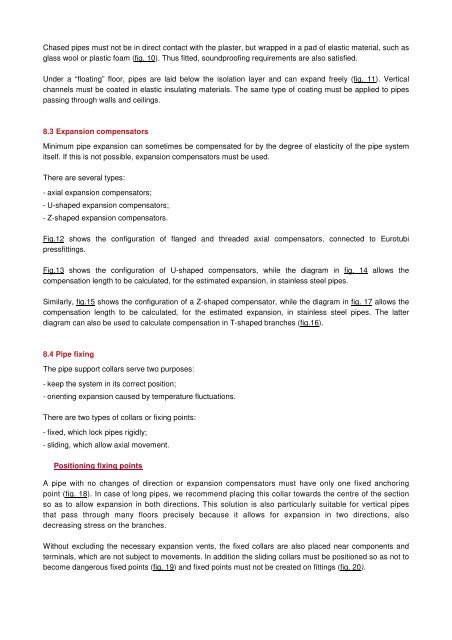Eurotubi Pressfitting System - Technical Guide ... - Damstahl
Eurotubi Pressfitting System - Technical Guide ... - Damstahl
Eurotubi Pressfitting System - Technical Guide ... - Damstahl
Create successful ePaper yourself
Turn your PDF publications into a flip-book with our unique Google optimized e-Paper software.
Chased pipes must not be in direct contact with the plaster, but wrapped in a pad of elastic material, such as<br />
glass wool or plastic foam (fig. 10). Thus fitted, soundproofing requirements are also satisfied.<br />
Under a “floating” floor, pipes are laid below the isolation layer and can expand freely (fig. 11). Vertical<br />
channels must be coated in elastic insulating materials. The same type of coating must be applied to pipes<br />
passing through walls and ceilings.<br />
8.3 Expansion compensators<br />
Minimum pipe expansion can sometimes be compensated for by the degree of elasticity of the pipe system<br />
itself. If this is not possible, expansion compensators must be used.<br />
There are several types:<br />
- axial expansion compensators;<br />
- U-shaped expansion compensators;<br />
- Z-shaped expansion compensators.<br />
Fig.12 shows the configuration of flanged and threaded axial compensators, connected to <strong>Eurotubi</strong><br />
pressfittings.<br />
Fig.13 shows the configuration of U-shaped compensators, while the diagram in fig. 14 allows the<br />
compensation length to be calculated, for the estimated expansion, in stainless steel pipes.<br />
Similarly, fig.15 shows the configuration of a Z-shaped compensator, while the diagram in fig. 17 allows the<br />
compensation length to be calculated, for the estimated expansion, in stainless steel pipes. The latter<br />
diagram can also be used to calculate compensation in T-shaped branches (fig.16).<br />
8.4 Pipe fixing<br />
The pipe support collars serve two purposes:<br />
- keep the system in its correct position;<br />
- orienting expansion caused by temperature fluctuations.<br />
There are two types of collars or fixing points:<br />
- fixed, which lock pipes rigidly;<br />
- sliding, which allow axial movement.<br />
Positioning fixing points<br />
A pipe with no changes of direction or expansion compensators must have only one fixed anchoring<br />
point (fig. 18). In case of long pipes, we recommend placing this collar towards the centre of the section<br />
so as to allow expansion in both directions. This solution is also particularly suitable for vertical pipes<br />
that pass through many floors precisely because it allows for expansion in two directions, also<br />
decreasing stress on the branches.<br />
Without excluding the necessary expansion vents, the fixed collars are also placed near components and<br />
terminals, which are not subject to movements. In addition the sliding collars must be positioned so as not to<br />
become dangerous fixed points (fig. 19) and fixed points must not be created on fittings (fig. 20).
















